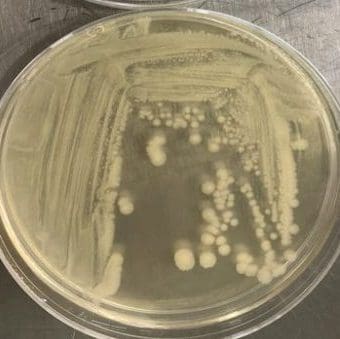
Get A Testing Quote
Shigella sonnei
STRUCTURE AND PHYSIOLOGY
Shigella sonnei is a Gram-negative, rod-shaped, nonmotile, non-spore-forming bacterium and has historically been responsible for causing dysentery. S. sonnei is highly clonal (genetically identical cells), and a selective group of lineages is found worldwide.
TRANSMISSION AND DISEASE
S. sonnei causes the disease shigellosis, an intestinal infection that is spread through contact with infected stool. Contact with contaminated food or water increases the likelihood of infection, and common symptoms include fever, abdominal pain, nausea, and diarrhea. Severe infection can lead to bacteremia and be life threatening.
DISINFECTION
Antibiotic-resistant strains of S. sonnei have been identified. Clinical samples were found to be multi-resistant to ampicillin and trimethoprim-sulfamethoxazole.
NOTES
Two strains of Shigella sonnei are referenced as required microorganisms on the FDA’s 2016 Consumer Antiseptic Rub proposed rule (81 FR 42912 at 42921).
REFERENCE(S)
Mayo Clinic Staff. “Shigella Infection“. Shigella Infection Complications. Mayo Foundation for Medical Education and Research, 24 August 2012. Retrieved 13 May 2015.
Holt, Kathryn E; Baker, Stephen; Weill, François-Xavier; Holmes, Edward C; Kitchen, Andrew; Yu, Jun; Sangal, Vartul; Brown, Derek J; Coia, John E; Kim, Dong Wook; Choi, Seon Young; Kim, Su Hee; da Silveira, Wanderley D; Pickard, Derek J; Farrar, Jeremy J; Parkhill, Julian; Dougan, Gordon; Thomson, Nicholas R (2012). “Shigella sonnei genome sequencing and phylogenetic analysis indicate recent global dissemination from Europe”. Nature Genetics. 44 (9): 1056–9. doi:10.1038/ng.2369. PMC 3442231
Jain, Sanjay K.; Gupta, Amita; Glanz, Brian; Dick, James; Siberry, George K. (2005). “Antimicrobial-Resistant Shigella sonnei”. The Pediatric Infectious Disease Journal. 24 (6): 494–7. doi:10.1097/01.inf.0000164707.13624.a7. PMID 15933557.
Share

